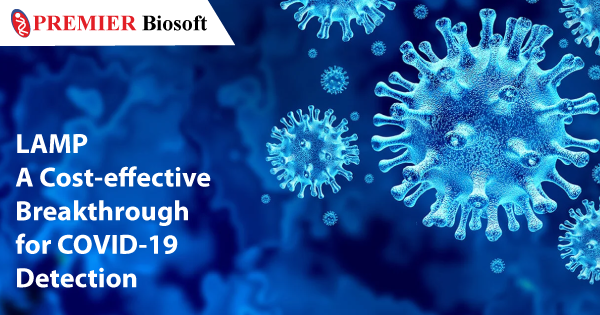Home >> Blog >> Loop Mediated Isothermal Amplification (LAMP) - A Cost-effective Breakthrough for COVID-19 Detection
Loop Mediated Isothermal Amplification (LAMP) - A Cost-effective Breakthrough for COVID-19 Detection

April 26, 2023
About the Disease
The COVID-19 pandemic is a global health crisis caused by the SARS-CoV-2 virus, which was first identified in December 2019. Since then, the virus has rapidly spread across the world, causing significant illness, death, and social and economic disruption.
The virus primarily spreads through respiratory droplets, making it highly contagious. The genetic material of COVID-19 is a single-stranded RNA molecule of approximately 30 kilobases in length. Understanding the genetic material of SARS-CoV-2 is crucial in the development of diagnostic tests, vaccines, and therapeutics for COVID-19.
Commonly Used Methods for COVID-19 Detection
There are several methods for detecting COVID-19, the disease caused by the SARS-CoV-2 virus. We have listed two commonly used methods below:
-
1. Polymerase Chain Reaction (PCR): PCR is a molecular diagnostic technique that amplifies and detects the viral RNA. This method extracts the viral RNA from the the patient (swab from the nose or throat), and amplifies it using PCR. The result is usually available within a few hours and is highly accurate. However, the PCR is expensive in terms of instrument requirements, skilled laboratory personnel, and reagents.
-
2. Rapid Antigen Tests: Antigen tests detect the presence of viral proteins, and the results are available within minutes. The test device contains antibodies that are designed to recognize and bind to the viral proteins. If the virus is present in the sample, the antibodies will bind to the viral proteins, forming a visible line on the test strip, indicating a positive result. Antigen tests are less accurate than PCR tests, and negative results may need to be confirmed with a PCR test.
The LAMP Method and How It Detects the COVID-19 Infection
Loop-mediated isothermal amplification (LAMP) is a nucleic acid amplification technique that can be used for the detection of RNA viruses. LAMP is a highly specific and sensitive method that amplifies target RNA sequences under isothermal conditions, making it faster and simpler than other nucleic acid amplification techniques such as polymerase chain reaction (PCR). The LAMP reaction produces a large amount of amplification product, which can be detected by visual inspection of turbidity, or by adding a fluorescent dye to the reaction mixture and measuring the fluorescence.
The LAMP assay targets specific regions of the SARS-CoV-2 genome, such as the N (nucleocapsid) gene, using a set of four to six primers. The primers recognize and bind to the viral RNA, initiating the amplification of the target sequence under isothermal conditions (usually at 60-65°C).
During the amplification process, the DNA polymerase enzyme synthesizes new copies of the target sequence, generating a large amount of DNA in a short amount of time. The amplified DNA can then be detected using various methods, such as gel electrophoresis or turbidity, depending on the specific LAMP assay used. In the case of SARS-CoV-2 detection, many LAMP assays incorporate a colorimetric indicator that changes color when the amplified DNA is present, allowing for visual detection of the virus.
The Advantages of the LAMP Method over PCR
The LAMP (Loop-mediated isothermal amplification) method offers several advantages over the conventional PCR (Polymerase Chain Reaction) method, some of those are:
-
1. Simplicity: The LAMP method requires fewer steps and can be performed at a constant temperature, whereas PCR requires temperature cycling and more steps, making it more complex.
-
2. Rapidity: LAMP is a faster method than PCR, with results obtained in less than an hour, while PCR can take several hours to complete.
-
3. Sensitivity: The LAMP method is highly sensitive and can detect very low amounts of target nucleic acid, while PCR has a higher limit of detection.
-
4. Specificity: LAMP is highly specific, as it uses four to six primers, reducing the likelihood of non-specific amplification, while PCR strategies use two primers and a probe.
-
5. Cost-effectiveness: The LAMP method does not require expensive equipment, making it more cost-effective than PCR, which requires specialized equipment.
Informatics Support for LAMP Primer Design
Manual designing 4-6 LAMP primers per target sequence can be daunting. Since all the primers are added together, prohibiting any cross reactions between themselves is essential. An efficient and robust informatics tool for designing high throughput LAMP primers can improve assay specificity, and efficiency, making LAMP a useful method for the detection of pathogens such as SARS-CoV-2 in clinical and research settings. The tool must be able to optimize primer design and minimize the likelihood of non-specific amplification or primer-dimer formation, which can affect assay performance. LAMP Designer is a tool that addresses the above challenges and designs highly specific and sensitive LAMP primers. It designs all the six primers (F3, B3, FIP, BIP, Loop F, and Loop B) for each target sequence ensuring that the primers do not bind among themselves. To learn more about LAMP Designer, please click here.
| Comment | Share |
|


